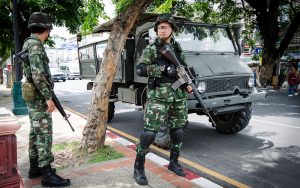Over the past few months, Thailand has seen yet another series of rising protests tied to its wider domestic political struggles. Though the evolution of the current protest movement is a notable development on its own terms, it also raises broader questions about how this factors into the country’s wider political dynamics, as well as its current and future evolution.
As I have noted before in these pages and elsewhere, the designation of Thailand as a “democracy” in terms of regime type and the focus on individual developments can at times obscure the fact that Thailand has been no stranger to democratic disruption and political instability. The country has experienced 19 attempted coups and 20 constitutions since the establishment of democracy in 1932. The most recent coup in May 2014 – a serious setback for democracy – was in fact a symptom of a longer-term struggle dating back to 2001, in which multiple elections had failed to ease political tensions and help the country’s elite adjust to wider societal changes.
Seen from this perspective, it might be tempting to just view the recent protests as nothing more than another cycle of resentment with political outcomes in Thailand. After all, though the scope of the current protests has grown in the past weeks – stretching to encompass everything from constitutional reform to human rights to the once-untouchable question of the Thai monarchy – they are partly a reaction to the results of long-delayed elections in March, which effectively saw a continuation of the military-led coalition that took power in the 2014 coup, and the later dissolution of the opposition Future Forward Party.
But such a cyclical view presents an incomplete picture of contemporary developments in the country. It fails to fully capture the dynamics that have built up over time, including the rising discontent that has accrued from previous rounds of political instability and the evolution of Thai state institutions such as the military and judiciary. It also fails to adequately appreciate the more unique features of the country’s current moment. In this respect, close observers of Thai politics have pointed to the nature of the protests themselves, which are more decentralized, are powered by social media networks, and have extended to regions beyond Bangkok. More generally, it does not help us answer broader and more difficult questions, including what is new about these dynamics, and how they might affect outcomes moving forward.
While these are not easy questions to answer, they are important ones to ask. Following spikes in June and July, the protests have already been some of the biggest since the 2014 coup, and they have thus far persisted in the face of coronavirus restrictions and government crackdowns, in spite of some initial skepticism. They also come at a particularly challenging time for the ruling government, which, apart from scrutiny on the various counts raised by the protesters, is also grappling with an anemic post-COVID-19 economy (in the second quarter, Thailand saw its largest economic contraction since the Asian Financial Crisis.) And beyond what is happening within Thailand, the country’s external environment has also markedly changed since 2014 with a confluence of wider subregional, regional and global trends and developments.
The scrutiny on evolving protest dynamics will no doubt continue to be the subject of headlines in the coming days, with large-scale demonstrations planned for September 19. But that should not detract from the importance of viewing them in perspective – not just in terms of where Thailand has been before, but where it is today and where it is headed in the coming years.
































